Sixth webinar of a series "Grounding and lightning protection: issues and problems arising in the design"
Webinar text. Page 3
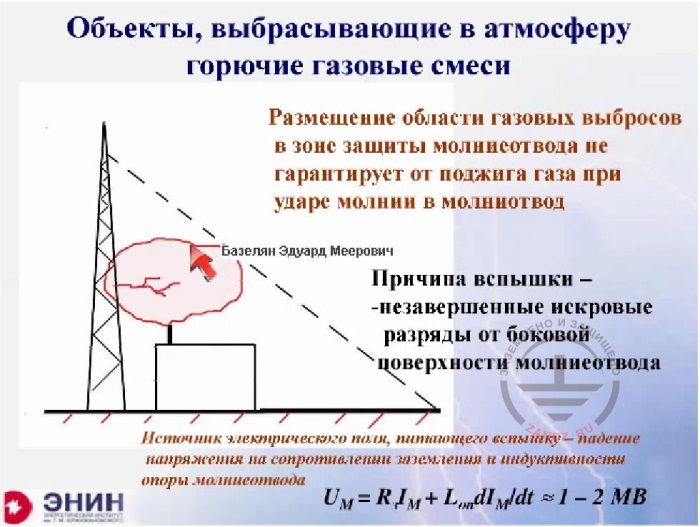
Objects that neting flammable gas mixtures into the atmosphere
And this ionization, weak ionization, is sufficient to lift the explosive ejection zone into the air . Even if this zone is inside the lightning protection zone, the lightning will never strike it. But in order to set it on fire ,even a small discharge, which develops from the surface of the lightning rod or from the service of the pressure vent valve or from a staircase that goes to the lightning rod. Or, finally, from the shovel of uncle Vasya, he left here in winter, when he was digging snow. Therefore, it is completely useless to remove or have a lightning rod in this respect.
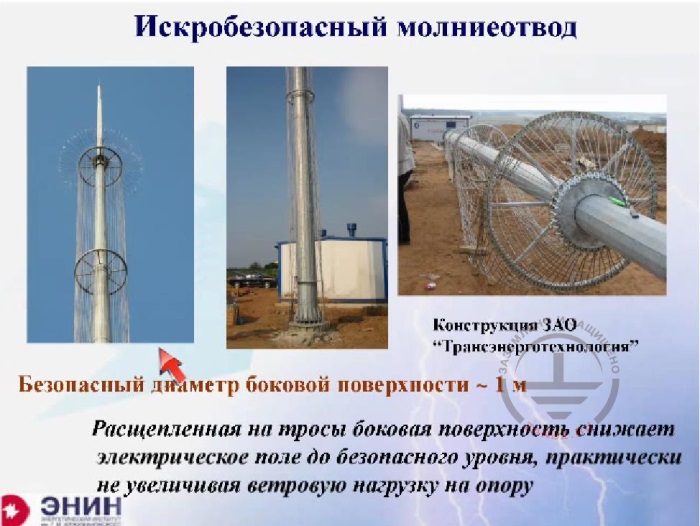
Sparkproof lightning rod
What can be done? We can do the following. You can make a lightning rod, with a complex surface , and the ionization of the side surface of the lightning rod will be absolutely impossible. If you make such a lightning rod of such a radius, and it appears that the radius should have been done of about 0.5 meters. Imagine a lightning rod of one meter in diameter is in a zone of high wind loads somewhere in the Near Arctic. What will happen to this lightning rod and how should it be fastened? Therefore, this design was invented. The surface was made of thin wires, so that air flows would more or less successfully pass through these wires.
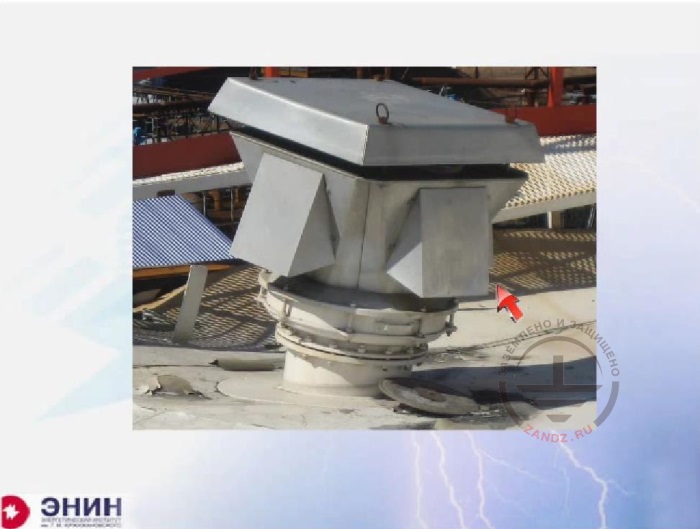
Pressure vent valve
They can occur from the vent valve, for example. You see how many are irregulaties and sharp edges on a pressure vent valve. They can cause discharges and they can set fire. I can make this vent valve of a flattened shape as a tank, or I can put a screen on it. Well, then I have a railing on the tank, and that railing on the tank is made of corners. And then these discharges will go from the sharp edges, corners. And then? If I eliminate this, then please don't forget about the shovel of uncle Vasya. I think this method is quite futile.
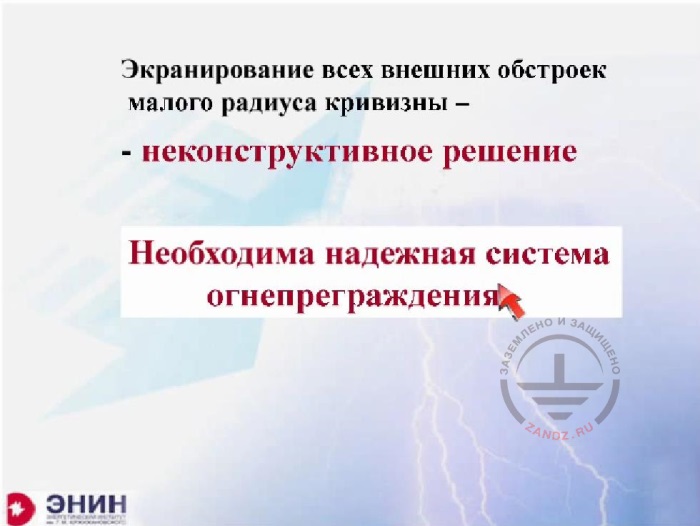
Screening of all auxiliary buildings of a small radius of curvature
It is a non-constructive solution, and only one system can be a constructive solution. We need to do so, that the burst of gases, that have gathered on the tank would not in any case penetrate into the interior of the tank. We need a reliable fire isolation system of pressure vent valves. And if you make these pressure vent valves, and it is not the task of specialists on high voltages, it is the task of fire-fighters. If you make such a system, you can unconditionally refuse from lightning rods at tank farms. And nobody, neither me nor anyone else, will offer you some other solution. I can stop again, if there are questions.
— No. I think we should continue. We better do it in the end.
— We shall continue. Let's continue. Then we should talk about one thing.
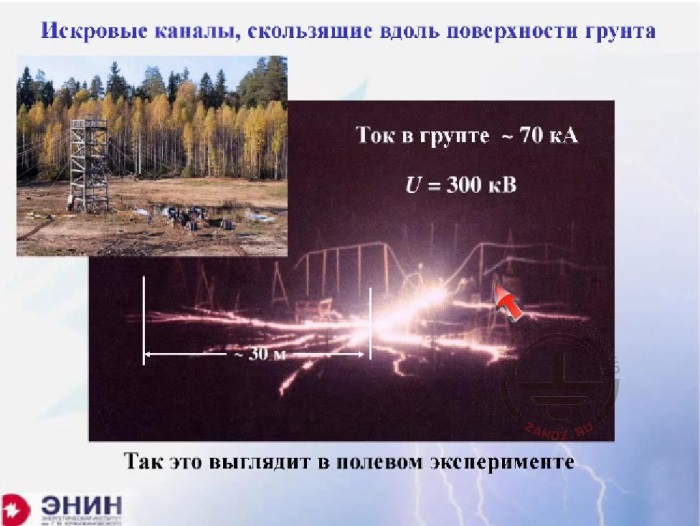
Spark channels sliding along the surface of the soil
We need to talk about processes in soil, about which we've talked a bit and changed the topic. I think I've already showed you one picture. It's a photo of wine-red color below, the one with the figure. This is an experiment, which was done by the Institute of Experimental Physics in Sarov. They took a normal rod electrode 2.5 m long, hit it into the ground and applied the pulse current of 70 kA to the electrode. What is 70 kA - I can tell you. The current of at least 80% of lightnings is, so it's a current of a good lightning. The photo I've been given is in front of you. So there are spark channels on the ground. In this case, there are about a dozen of them. And the ultimate length of these channel is up to 30 meters. Now imagine that such a channel with a temperature of not less than 6000 degrees, is in contact with the area of tank fuel leakage. For example, oat oil loading rack or area with the heavy gas fractions on the soil surface. A flash is inevitable here. And the ignition of these things is inevitable too. In order to form a channel 30 m long, the voltage of 300kV is enough in this experiment. What is written in the regulations? How is a safe distance chosen? These documents, almost all of them without exception, consider that in order to generate a spark channel 1m long, 300kV is required. A thirtyfold error, you know?
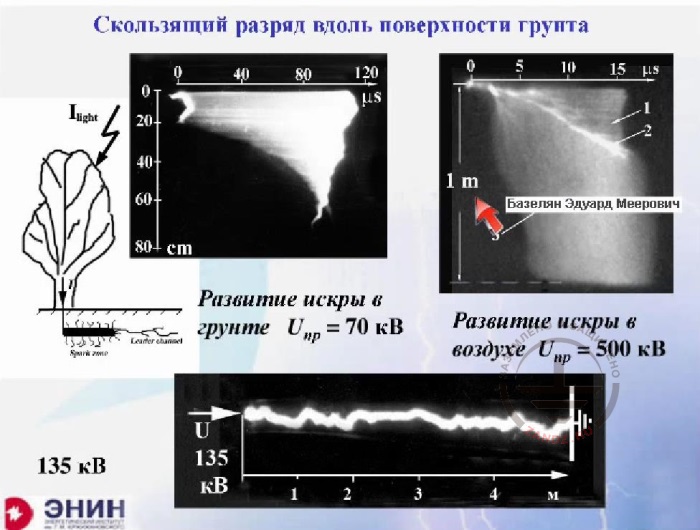
Sliding discharge along the surface of the soil
The process of formation of these channels is very well developed. We understand why these channels are moving so at low voltages. To heat a channel in the air, ionization zone of a colossal size is required. And in order to heat the channel on the ground, no ionization zone is required, because the channel is heated by leakage currents. The channels exist and the only thing we can do with them - we can either keep them out of that area, which we need.
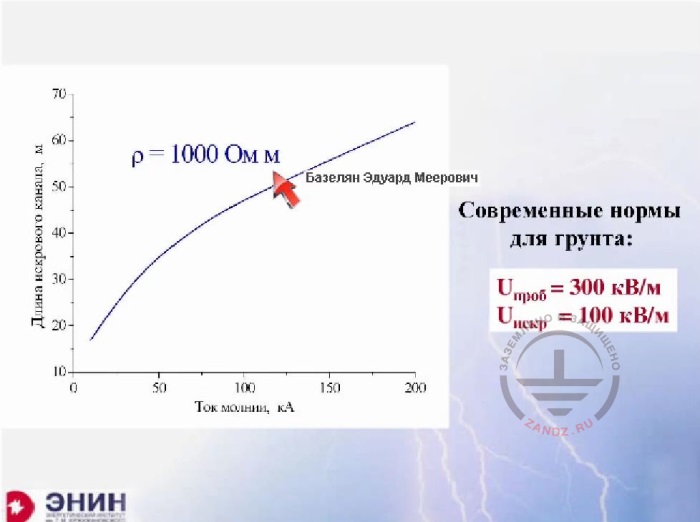
Modern standards for soil
The length of these channels, I have to repeat, depends on the lightning current. For example, at the lightning current of 100 kA and soil resistivity of 100 ohms / m, the length of the channel will be not less than 50 m. This is confirmed by experiment. What to do now? How to protect a dangerous area from these channels?
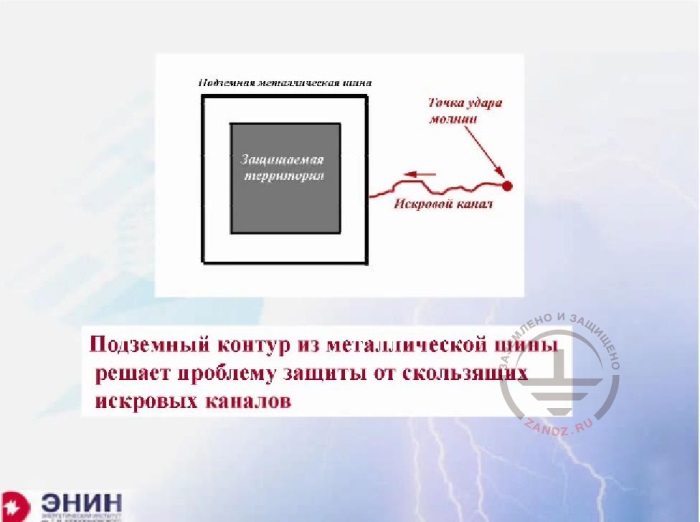
An underground contour of a metal bus
I want to say one thing. This dangerous area is not the only a area of current leakage, this is not the area where heavy gas fractions gather. For me and not only for me, these channels present a significantly greater threat to me in the following respect. If you have underground utilities. First of all, automation control circuit, then such a channel, being in contact with an underground cable, totally destroys this cable. You see? Automation control circuit systems break because of these channels. What can be done? The option is quite simple. You have areas where the channel can not be allowed. Here you have leaks, here - cables, here - everything you want. And now I am doing this thing. Imake a catenary wire lightning rod around this area. But I am making it not in the air. I put it in the ground. I dig a trench, it is better to hire somebody, dig a trench to a depth of about 0.5 meters, and put a normal grounding bus inside. In wire rods, tapes, whatever you want. This distance between the grounding contour, which I made and the area that needs to be protected should be in the range of 10, but not less than 5 m. What will happen to the channel? The channel will run against my ground electrode system The lightning current will spread on the ground electrode, the electric field in the soil will weakene and nothing else will happen. This is it. Nothing more is required. It's a very simple tool that is very easy to do and is very effective and I can only offer one competitor to this tool. And it only works for catenary wire lightning rods. Do you remember, I have outer lightning rods there? Supports, wires. I will make a ground electrode system for the support in the form of a horizontal beam. And I will direct the horizontal beam not to the side of my tank farm but to the neighbors outside our zone. Then the channel that will start from the end of this ground electrode will go in that direction. It will exist but it's current will be safe for me and for the tank farm. This event, if it is permissible under the terms of the location of the tank farm is extremely effective, or slightly better than what I am suggesting.
Block of questions and answers
— While during your speech, we received a lot of questions.
— OK, Nadezhda.
— I will read them one by one. A question about a gas cloud, a big question. Is there some kind of regulatory framework that determines what is the concentration of gases ..
— You know. Yes, there is this regulatory framework. It is very affordable, because even the AD 34 contains rules that firefighters gave to specialists in lightning protection and they appear in AD 34. Now, these zones are also mentioned in the regulations on fire safety for a variety of objects. They are all available. This document, which is very easy to find on the Internet, but don't search on the net, search in AD 34. There's a section relating to the second category of lightning protection, you will see general figures there.
— As I understand the question refers to the fact that there is a working condition when the cloud is not explosive and there is a critical condition that happens once in 100 years.
— No, we are talking about another thing. We are not talking about the emergency releas because emergency releases are not protected by our requirements at all.
— That was the question.
— We are talking about the emissions that exist in normal breathing mode over the tanks. These emissions are regulated by fire-fighters. Two days ago, I've heard on the radio that we have to say fire-fighers, not a fireman. So, the fire-fighters regulate these emissions only for the normal functioning of objects. That means these emissions are almost always there.
— There was another question. An example was given. An underground pipeline pulls out from the ground to 1 m to install the valve of some device. How to protect this area?
— Does it need to be protected? That's the question It means, that if the walls of the pipeline are thicker than 4 mm, it can remain unprotected. - Why should it be protected? This is completely optional. Another thing, if you have a gas distribution device with the high-pressure pipes and a throttle device and then the low-pressure pipes. Such a gas distribution device can be in any country, in any village. Protection requirements are necessary. And be sure you have a lightning rod and the lightning rod is put even in those cases when there are two trees of 30 m high near.
— there is question in connection with the fact that the expert made a remark to the author the question that he needed to perform a lightning protection of the site. A gas pipeline, which proJects above the ground to 1 meter.
— I'll tell you one more time, you see, if you have a pipe more than 4 mm thick, you don't have to do anything. For example, you can drag a gas pipeline from Moscow to St. Petersburg, not in the ground but in the air and you won't do any lightning protection, if you only have this pipeline. But if you have a thin-walled pipe, then it must be placed in a protection zone as it is done for any object outside facility, providing lightning protection of the second level of protection at the request of "Gazprom".
— There is also a question, what should be done to reduce the voltage?
— Great question. You know, we've been working on the device, construction of a lightning rod. Construction of grounding devices that would reduce step voltage to a level that is prescribed by electrical safety for short-circuit currents. It is prescribed there not have a voltage higher than 600 V. This is the requirement, there is no other. You see? I talked about that on purpose. It is only possible to fulfill this requirement for a situation when your lightning current is spreading in the following way. You either make a solid metal grid at this place, then wherever a man is, he will always be practically under the same potential. Or you make insulation coating. This insulating coating, is typically made of water-resistant material. For example, the territory is asphalted. And again it is written in AD 34. But it is unreal to make a grounding contour,which would reduce the voltage lower than 600 V at the spreading of lightning high currents. It is practically impossible to do that.
— Okay. Next question. Please specify whether it is planned in the near future, to form new correct regulatory documents for grounding and lightning protection?
— You know, this question is not for me. Just because. In order to make regulations, funding is required. We always say that they are badly needed. We say that but we are not heard. If to talk about the industry standards, whose standard is most perfect, I would say, first of all, the standard of "Gazprom". Because this standard is quite recent. Specialists of different levels were involved and this standard is quite good. But if we talk about Russian documents, then it is hard to imagine today, who would dare to find the money for this work in a situation we have today. I think it is impossible to count on that in the nearest future.
— I will explain. The audience is worried that the formalism of expert organizations is irresistible, and to meet their demands and fulfill them safely ...
— You will see what I'm stalking about. I offered you catenary wire lightning rods, right? They won't be violently opposed by the regulating organizations, because they are permissible by our regulations. I offered you to unite a lightning rod which is not contrary to absolutely anything. I offer you protection from sliding discharges by , in fact, lightning rods which were dug into the ground. And it also does not contradict anything. The only thing that perhaps could be met with hostility - it is my proposal, according to which it is necessary to make a safe and clean fire isolation fence and remove the lightning rods from tank farms. Do you think I'm one that does this? Frankly speaking, I quoted the technique that is used in a number of countries. For example, in the United States, tank farms are not protected , but in Europe - they are. But I believe that the Americans are right, not the Europeans. But we can't do anything here. Until we change the legislation, we will put lighning rods. But let's put them so that they don't bring any harm.
— So, one of those questions that I missed, was the question: whether it is necessary to use the described design for catenary wire lightning rods also for rod lightning rods?
— Generally speaking, oyou can do that. It is generally possible. Maybe but my heart is not in in these rod lightning rods, and I'll tell you why. Their height is very big, you know? I'll give you an example. Not so long ago we analyzed lightning protection of a plant, which is engaged in processing hydrocarbon fuels and which had catenary wire lightning protection. The project was not only the Russian, it was also French. They differed in one thing: both of them had rod lightning rods, but their height was a bit different. I can't remember exactly. The French were higher than 90 meters, and Russians - over 80 meters, or vice versa. But the lightning rods were almost of a hundred meters. There were 16 lightning rods. When we proposed the construction, started to think of an alternative, we saw that the lightning rods structure can be reduced in half, if we apply wires, and make 6 supports ( we are not talking about wires) instead of 16. You see? Catenary wire lightning rods - it is a tradition to some extend, but not a very good tradition.
— In general, I read the main questions relating to our today's topic, if I missed something or you still have questions - please go ahead and ask. And there is something that doesn't relate to today's topic, it will be a question for grounding of small objects such as UTS of modular buildings located on the territory of high voltage ground.
— You know what? You just have to fulfill the requirements, which are written in the regulatory document. I can't suggest anything else. Because it is simply unreal to do something similar to the horizontal buses, which l recommend, on small objects. Replace the soil if it is urgently necessary, you can of course do that, but it's a different arrangement. I had to face a soil cut and fill. I know two cases. But once this change has been made by a dredger, which had been working on the Volga for a few months. The second case - the replacement of soil in the trenches of approximately 30 m long and 1.5 meters deep- but that's a large number of hoppers. It's expensive, you understand? Perhaps that's it. I have a happy opportunity to congratulate everyone with the Happy New Year.
Any questions left? Send them to our technicians and you will receive detailed reasoned answers.
<< Previous Page
Slides 11 to 22
Related Articles:



